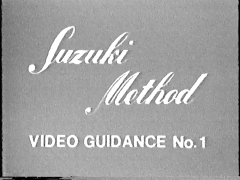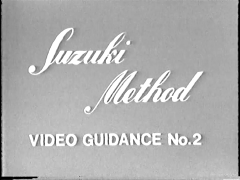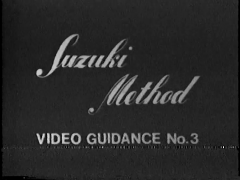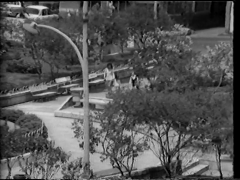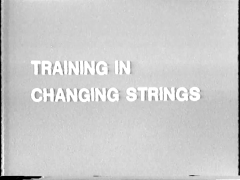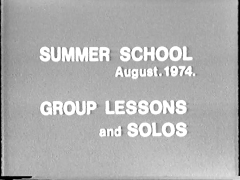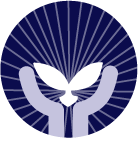The Suzuki Method Video Guidance Series
This series was produced in the mid-1970’s under sponsorship of the Sony Corporation. The videos were made on the recital hall stage of the Talent Education Research Institute, at the National Concert in Tokyo and in venues around Matsumoto used for the TERI Summer School.
Yuko Mori was Sayo-chan’s instructor. Miss Mori was a prominent teacher at TERI, had many students participate in the Japanese Children’s Tour Groups, and gave teacher workshops in the US and in Europe.
The translator heard on the videos is Sen Nishikawa.
Summaries
Video 1: The Law of Ability and the Mother Tongue Method of Education - 60 minutes
Dr. Suzuki gives a lecture about the basic principle of his method, the belief that every ability, including musical skills is acquired and not inborn. Just the way children learn their mother tongue to the most delicate nuances of the local dialect, they can acquire musical abilities by an exposure to masterful performances and an informed guidance. This video also includes Dr Suzuki’s brief introduction to his teaching method as well as fragments of masterclasses and group performances at Summer School Matsumoto Japan (August 1974) and All Japan Conference, Budokan Hall Tokyo (March 23, 1975).
Video 2: Summary of the Development of Enthusiasm and Ability - 75 minutes
This video discusses how to develop enthusiasm for practice in the child. In the first half of the video. shares his philosophy of how to motivate a student The second half shows examples of group lessons led by Dr. Suzuki.
Video 3: Practice at Home - Sayo-chan’s Ability is Developed with Practice at Home - 60 minutes
Dr. Suzuki demonstrates methods for practicing at home with children, beginner posture problems, how to set up a beginner bow hold, how teachers can help parents be better home practice helpers, group class staccato games, and how the bow fingers and arm work together to play chords. To illustrate his point on chords, Suzuki plays a folk song from his home village in Japan. Dr. Suzuki demonstrates the use of video and tape recording for home practice. Suzuki works with an older student who plays Handel Bourrée, and a 3 year old who plays Gossec Gavotte.
Video 4: Sayo-chan’s Accomplishment Record and Performances from the 1975 All-Japan Conference - 59 minutes
This video is the story of Sayo-chan’s development from a beginner at 2 years and 10 months, through individual lessons, practice at home with her older sister and group lessons. Performances of Gossec Gavotte, Paganini Witches’ Dance, Handel Bourrée, Schumann Two Grenadiers, Vivaldi Concerto in G Minor (I) and the Bach Double at age 4 demonstrate Sayo-chan’s musical development. In addition, there are performances from the 1975 All-Japan Conference ending with Dr. Suzuki playing piano surrounded by hundreds of children playing Twinkle.
Video 5: Training in Tonalization - 62 minutes
In this video, Suzuki teaches components of a beautiful tone. He emphasizes the importance of teaching beautiful tone before pieces, listening for the resonance of open-string pizzicato to match, and producing a constant volume of sound with beautiful tone. Components discussed include bow balance, vibrato, circle bows, the “Kreisler highway,” slurs, staccato, legato, and dynamics.
Video 6: Training in Changing Strings - 63 minutes
In this video, Dr. Suzuki explains the importance of balanced string changing as a means of achieving optimal tone production. He breaks down the nuances of each string crossing and the ideal action of the arm and elbow in relation to the movement(s) of the bow. The video includes demonstrations, teaching, and playing examples.
Video 7: Summer School - August 1974 - Group Lessons and Solos - 57 minutes
This video includes footage of children of all ages playing the violin at a high level, meaning with proper position, using bow strokes that produce a beautiful tone, and with elegance, musicality and grace. Dr. Suzuki provides an explanation of why and how to use Tonalization with students, using the whole arm using the elasticity of the horsehair to make the strings resonate. He explains that once a student has learned a piece well and is able to play it through without mistakes, then it is time to begin, infusing the music with spirit and making the tones ring and sound beautiful.

